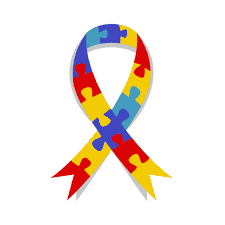Parents, nannies and children can wear difference colored socks on April 2nd to celebrate World Autism Awareness Day. There are different variations of Autism Spectrum Disorder (ASD) and all are celebrated in April to help educate families about World Autism Awareness. There are many ways Autism can present itself in an individual, but there are some overarching common symptoms that can be seen throughout the spectrum.
When thinking about ASD or Autism Spectrum Disorder, it is helpful to think of a rainbow. Individuals on one end of the spectrum can have extreme abilities and they may be particularly bright in one or more subject areas. Some obsess over an interest in an area of exceptional talent. It’s thought that Einstein and Mozart were both on this end of the spectrum with ASD. Some artists and celebrities are also on the spectrum including Tim Burton, the creator of A Nightmare Before Christmas, actor Dan Aykroyd, and musician Courtney Love. Individuals on the other end of the spectrum, however, are more limited in their abilities and communication. Their ASD is more apparent, and they often require more support and assistance in their daily functioning.
The exact cause of Autism is not known, but it is believed to be a combination of genetic and environmental factors.
Common symptoms seen with ASD though include social skill difficulties, repetitive behaviors, speech and nonverbal communication, and again unique strengths and differences. Given ASD is a spectrum, those diagnosed have a wide variety of challenges and strengths, unique to each individual. Thus, one person may experience the disorder in a very different way from one another.
Autism Spectrum Disorder is most commonly seen in males and the CDC estimates males are diagnosed about 4.5 times more than females each year. A lack of social development is often an early indicator of ASD. Outward behaviors, often appearing around the ages of 2 and 3, can lead to recommendations for a child to be evaluated. Children with ASD may fixate on certain topics, or exhibit atypical behaviors such as flapping hands, spinning, tapping, repetitive movements, or language. Children with ASD may have difficulty with eye contact as it makes them feel uncomfortable. Light and sound sensitivities are another potential sign of ASD. Finally, many ASD children are in their own world, not exploring or interacting with things around them.
Several years ago, I had a very intelligent student with ASD, and if he completed his schoolwork, he would have gotten an A. Most of the time though, this student was off in his own world. One example was reading time. He would take out the book the class was reading and just pretend to follow along. Then, he would take a book that he wanted to read and place it inside the book the class was reading. He made it look like he was reading along with everyone else, but he was mentally in his own world.
Individuals on the spectrum can be very bright.
Their social behavior, however, can make it difficult for people to see their capabilities and intelligence. Children with Autism might also have trouble interacting or playing or relating with others. They sometimes struggle to develop relationships with others and lack an understanding of social norms. In all, ASD is a spectrum – no two individuals are the same and the way the disorder presents itself can vary.
To learn more, a Special Education course is available with enrollment in the Specialist Childcare program at the the Nanny Institute.


Recent Comments